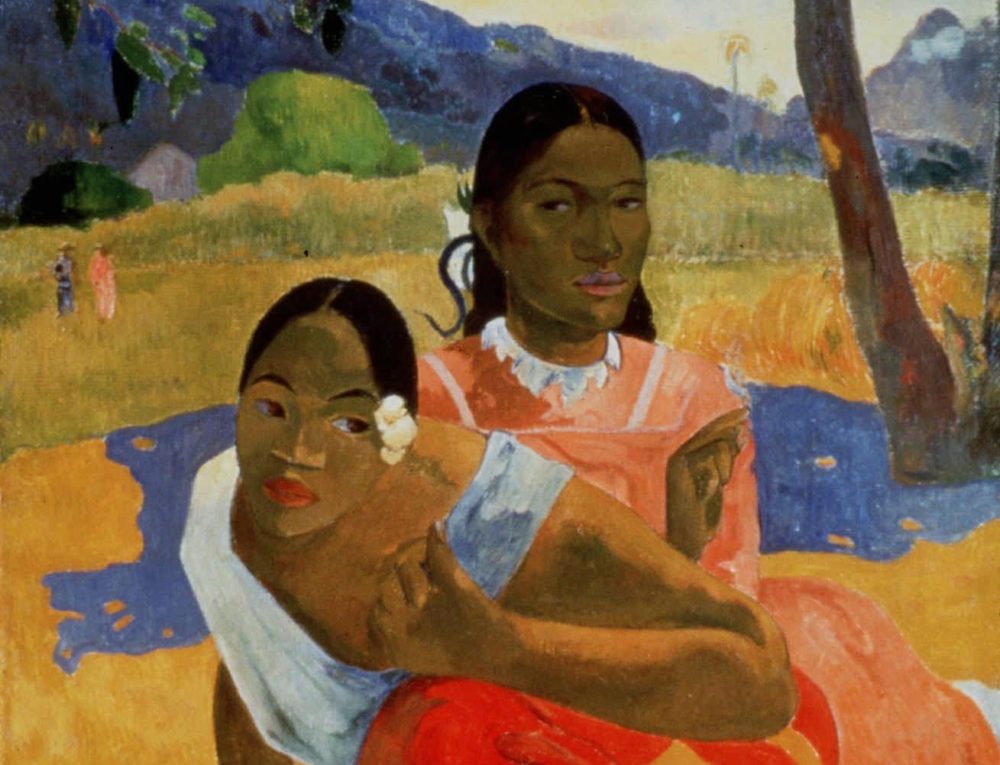
Paul Gauguin, Nafea Faa Ipoipo (When Will You Marry?). Photo Artothek/Associated Press via New York Times.
A new record price for an artwork, nearly $300 million, may have been achieved with the sale of a Paul Gauguin canvas by a Swiss collector. The buyer is rumored to be the Qatar Museums.
The seller, Rudolf Staechelin, a retired Sotheby’s executive who now lives in Basel, confirmed the sale this afternoon to the New York Times, but declined to identify the buyer or disclose the price. The 1892 oil painting, Nafea Faa Ipoipo (When Will You Marry?), is one of over 20 works in his collection of Impressionist and Post-Impressionist art. Prior to the sale, the Gauguin canvas had been on loan to the Kunstmuseum in Basel for close to fifty years. (See Buy, Sell, Hold: How’s The Market for Gauguin Prints.)
Sources tell the Times that Qatar Museums is the purchaser. Qatar is already home to the painting that set the previous record for most expensive artwork, Paul Cézanne’s The Card Players, purchased by its royal family in 2011 for a price said to have been $250 million. The late Qatari ruler Sheikh Saud Al-Thani was a prolific collector (see Qatar’s Sheikh Saud Died of Complications Related to Heart Condition and What Are The Top 10 Al-Thani Family Art Acquisitions?), and other Qatari buyers have made major art purchases in recent years. The country’s acquisitions allegedly include Cézanne’s La Montagne Sainte-Victoire vue du Bosquet du Château Noir, offloaded by Detroit’s Edsel & Eleanor Ford House to the tune of $100 million in 2013 (see Secret $100 Million Cézanne Sale in Detroit).
New York art advisor Todd Levin, who had heard rumors of the Gauguin sale, told the Times that “The price quoted to me at that time was in the high $200 millions, close to $300 million.”
As the Kunstmuseum is currently closed for renovations, which began last month, the painting will spend the next year on tour, beginning this month with a Gauguin exhibition at Basel’s Beyeler Foundation before traveling to Madrid’s Reina Sofía museum and the Phillips Collection in Washington, DC. The new owners will take possession of the canvas next January.
Paul Cezanne, The Card Players (1892–93). Purchased by Qatar for roughly $250 million in 2011.
The sale was arranged after a dispute with the local government over whether Staechelin’s collection could travel while the institution was closed; the loan contract stipulated that the work must remain on public view. “We are painfully reminded that permanent loans are still loans. The people of Basel do not own these, and they can be taken away at any moment,” said the museum in a statement bemoaning the work’s loss. Staechelin acquired the painting, along with the rest of his collection, from his grandfather and namesake, a Swiss merchant who collected during World War I and the following years.
Staechelin told the Times he initiated the Gauguin sale “mainly because we got a good offer. The market is very high and who knows what it will be in 10 years. I always tried to keep as much together as I could, [but] over 90 percent of our assets are paintings hanging for free in the museum. It’s not a healthy financial risk distribution. . . . For me they are family history and art. But they are also security and investments.”
Curious to know more about Gauguin? Maybe you can snag some tickets to Keanu Reeves’ talk on the artist at the Beyeler Fondation this weekend (see Keanu Reeves to Give Talk on Gauguin—Say What?).